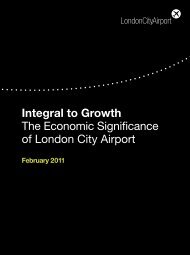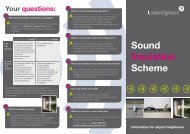Sustainability Stratergy and Action Plan - London City Airport
Sustainability Stratergy and Action Plan - London City Airport
Sustainability Stratergy and Action Plan - London City Airport
Create successful ePaper yourself
Turn your PDF publications into a flip-book with our unique Google optimized e-Paper software.
16<br />
<strong>London</strong> <strong>City</strong> <strong>Airport</strong><br />
<strong>Sustainability</strong> Strategy <strong>and</strong> <strong>Airport</strong> <strong>Sustainability</strong> <strong>Action</strong> <strong>Plan</strong><br />
2012 - 2014<br />
Energy <strong>and</strong> Emissions<br />
2.2 Perhaps the most significant challenge for<br />
sustainability is the threat of climate change. In<br />
accordance with the Air Transport White Paper -<br />
The Future of Air Transport (2003) <strong>and</strong> subsequent<br />
aviation <strong>and</strong> related policy, airport operators are<br />
encouraged to adopt practices that minimise<br />
the impact of their activities on climate change.<br />
This includes taking voluntary action to control<br />
greenhouse gas emissions. Such action could<br />
include emissions reporting <strong>and</strong> setting targets at a<br />
company level.<br />
Energy consumption <strong>and</strong> emissions are intrinsically<br />
linked. <strong>Action</strong>s to reduce the airport’s carbon<br />
footprint will be delivered through the adoption<br />
of energy efficiency measures, low carbon<br />
energy solutions <strong>and</strong> potentially, the utilisation of<br />
renewable energy. Carbon reduction will also be<br />
promoted in other ways, through for example waste<br />
management initiatives; encouraging sustainable<br />
transport; the design <strong>and</strong> construction of efficient<br />
new buildings <strong>and</strong> plant; <strong>and</strong>, working more closely<br />
with staff, tenants, concessions <strong>and</strong> passengers to<br />
deliver our objectives.<br />
We are committed to high st<strong>and</strong>ards of energy<br />
efficiency <strong>and</strong> will adopt a series of measures<br />
which will help drive down energy consumption at<br />
the airport. We have established two objectives for<br />
energy <strong>and</strong> emissions, which are:<br />
• To reduce energy consumption through targeted<br />
efficiency measures<br />
<strong>and</strong>,<br />
• to stabilise the emissions associated with the<br />
ground operations at the airport, with the goal to<br />
reduce the total amount of these emissions over the<br />
longer term.<br />
<strong>London</strong> <strong>City</strong> <strong>Airport</strong> has a relatively limited number<br />
of buildings, operating scheduled flights from a<br />
single terminal building <strong>and</strong> 18 st<strong>and</strong>s distributed<br />
over two piers. There are also a number of support<br />
buildings, including <strong>City</strong> Aviation House, the main<br />
administrative offices for the airport, two industrial<br />
type sheds, the Fire Station <strong>and</strong> the Jet Centre.<br />
As shown in the table below, the primary fuel<br />
source powering buildings at the airport is<br />
electricity, which represents around two thirds of<br />
total energy consumed. Gas makes up less than<br />
one third.<br />
Gas <strong>and</strong> Electricity Used at LCY in 2010<br />
Total (kWh) Per Passenger (kWh)<br />
Electricity 9,192,843 3.295<br />
Gas 3,001,316 1.076<br />
We also consume diesel, which is predominantly<br />
used by ground services, unleaded petrol for staff<br />
travel, <strong>and</strong> a small amount of LPG which is used for<br />
fire training. These are considered further below.<br />
LCY is committed to ongoing improvements in<br />
energy efficiency <strong>and</strong> will take a series of measures<br />
to reduce energy dem<strong>and</strong> at the airport. We have<br />
already undertaken a number of steps to achieve<br />
this:<br />
• The utilisation of Fixed Electrical Ground Power<br />
(FEGP), which replaces less efficient diesel mobile<br />
ground power units;<br />
• Trialling energy efficient lighting on the aprons;<br />
• In 2009 we made several improvements to the<br />
airport, including replacing boilers, pumps <strong>and</strong> fans<br />
with newer, more efficient systems. A programme of<br />
upgrades to the terminal building is also underway<br />
which will lower the energy requirements of the<br />
building services through retrofitting energy<br />
efficient systems, upgrading the building’s<br />
energy monitoring capabilities <strong>and</strong> making other<br />
consequential improvements to the building in<br />
accordance with Building Regulations Part L2a.<br />
We will ensure that future capital expenditure<br />
programmes include an evaluation of energy<br />
dem<strong>and</strong> <strong>and</strong> associated emissions as part of the<br />
criteria for decision making.<br />
We are exploring the longer term possibility of<br />
accepting heat through a district heating main<br />
provided via the Greater <strong>London</strong> Authority’s <strong>London</strong><br />
Heat Network. District heating is regarded as<br />
an energy efficiency measure, as it allows end










